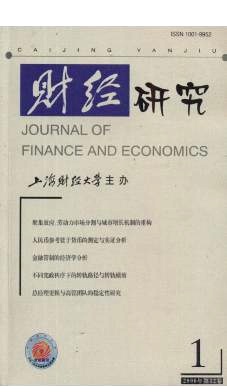广告收入上限的规制涵义——基于电视产业的分析
财经研究 2006 年 第 32 卷第 01 期, 页码:135 - 146
摘要
参考文献
摘要
文章在电视产业规制实践的基础上,把节目编排作为衡量电视传播企业的主要产出,在理论上证明了当观众的总需求固定时,三类电视频道都存在基于DEA的广告收入上限,其规制涵义在于,当把广告收入看作规制者给予电视传播企业的一种转移支付的形式时,基于DEA的广告收入上限给出了促进三种经营方式竞争的规制框架,因此,国家对广告收入上限的规制有着合理的理论基础。
[1]Vaglio A.A model of the audience for TV broadcasting:Implications for advertisingcompetition and regulation[J].International Review of Economics and Business,1995,42:33~56.
[2]Gabszewicz J,Laussel D,Sonnac N.TV-broadcasting competition and advertising[R].Working Papers from Catholique de Louvain—Center for Operations Research and E-conomics,2000.
[3]Nilssen T,L Sogard.TV advertising,programming investments,and product-market oli-gopoly[R].Industrial Organization from Economics Working Paper Archive atWUSTL,2003.
[4]张卫东,李志.电视产业如何进行经济规制[J].改革,2004,(6):23~28.
[5]Spence M Owen B.Television programming,monopolistic competition and welfare[J].The Quarterly Journal of Economics,1997,91:103~26.
[6]Wildman S S Owen B M.Program competition,diversity,and multichannel bundling inthe new video industry[C].Videl media competition:Regulation,economics and technol-ogy[A].Columbia University Press,New York,1985.
[7]O’Hagan J Jennings,M.Public broadcasting in Europe:Rationale,licence fee and otherissues[J].Journal of Cultural Economics,Vol.,2003,27:31~56.
[8]黄孝俊,叶琼丰.节目欣赏指数及其应用前瞻[J].中国传媒报告,2002,(1):85~95.
[9]Brown A Cave M.The economics of television regulation:A survey with application toAustralia[R].The Economic Record,1992,68(202):377~394.
[10]Nolan D.Bottlenecks in pay television:Impact on market development in Europe[J].Telecommunications Policy,1997,21(7):597~610.
[11]Shavitt Y,Winkler P,Wool A.On the economics of multicasting,netnomics[J].2004,6(1):1~20.
[12]Armstrong M.Competition in two-sided markets[M].mimeo,Nuffield College,Ox-ford,2002.
[13]Rochet J-C Tirole J.Platform competition in two-sided markets[J].Journal of theEuropean Economic Association,2003,1(4):990~1029.
[14]Evans D S.The antitrust economics of multi-sided platform markets[J].Yale Journalof Regulation,2003,20(2):325~381.
[15]Becker G S,K M Murphy.A simple theory of advertising as a good or bad[J].Quar-terly Journal of Economics,1993,(9):42~64.
[16]Nilssen T,L Sorgard.The TV industry:Advertising and programming[M].mimeo.No18/2001,Memorandum from Oslo University,Department of Economics,2001.
[17]Kind H J,Nilssen T Sogard L.Advertising on TV:under-or overprovision[M].mimeo,Norwegian School of Economics and Business Administration,2003.
[18]Motta M,Polo M.Concentration and public policies in the broadcasting industry:Thefuture of television[J],Economic Policy,1997,12(25):294~334.
[19]Wright D J.Television advertising regulation and program quality[J].Economic Re-cord,1994,70(11):361~367.
[20]Shleifer A.A theory of yardstick competition[J].Rand Journal of Economics,1985,16(3):319~327.
[21]Bogetoft P.DEA-based yardstick competition:The optimality of best practice Regula-tion[J].Annals of Operations Research,1997,73:277~298.
[22]Bogetoft P.DEA and activity planning under asymmetric information[J].Journal ofProductivity Analysis,2000,13:7~48.
[23]Bowlin W F.Measuring performance:An introduction to data envelopment analysis(DEA)[J].Journal of Cost Analysis,1998(3):3~27.
⑤防止节目虹吸是付费电视的一项重要规制原则,参见张卫东、李志:《电视产业如何进行经济规制》,载于《改革》,2004年第6期。
[2]Gabszewicz J,Laussel D,Sonnac N.TV-broadcasting competition and advertising[R].Working Papers from Catholique de Louvain—Center for Operations Research and E-conomics,2000.
[3]Nilssen T,L Sogard.TV advertising,programming investments,and product-market oli-gopoly[R].Industrial Organization from Economics Working Paper Archive atWUSTL,2003.
[4]张卫东,李志.电视产业如何进行经济规制[J].改革,2004,(6):23~28.
[5]Spence M Owen B.Television programming,monopolistic competition and welfare[J].The Quarterly Journal of Economics,1997,91:103~26.
[6]Wildman S S Owen B M.Program competition,diversity,and multichannel bundling inthe new video industry[C].Videl media competition:Regulation,economics and technol-ogy[A].Columbia University Press,New York,1985.
[7]O’Hagan J Jennings,M.Public broadcasting in Europe:Rationale,licence fee and otherissues[J].Journal of Cultural Economics,Vol.,2003,27:31~56.
[8]黄孝俊,叶琼丰.节目欣赏指数及其应用前瞻[J].中国传媒报告,2002,(1):85~95.
[9]Brown A Cave M.The economics of television regulation:A survey with application toAustralia[R].The Economic Record,1992,68(202):377~394.
[10]Nolan D.Bottlenecks in pay television:Impact on market development in Europe[J].Telecommunications Policy,1997,21(7):597~610.
[11]Shavitt Y,Winkler P,Wool A.On the economics of multicasting,netnomics[J].2004,6(1):1~20.
[12]Armstrong M.Competition in two-sided markets[M].mimeo,Nuffield College,Ox-ford,2002.
[13]Rochet J-C Tirole J.Platform competition in two-sided markets[J].Journal of theEuropean Economic Association,2003,1(4):990~1029.
[14]Evans D S.The antitrust economics of multi-sided platform markets[J].Yale Journalof Regulation,2003,20(2):325~381.
[15]Becker G S,K M Murphy.A simple theory of advertising as a good or bad[J].Quar-terly Journal of Economics,1993,(9):42~64.
[16]Nilssen T,L Sorgard.The TV industry:Advertising and programming[M].mimeo.No18/2001,Memorandum from Oslo University,Department of Economics,2001.
[17]Kind H J,Nilssen T Sogard L.Advertising on TV:under-or overprovision[M].mimeo,Norwegian School of Economics and Business Administration,2003.
[18]Motta M,Polo M.Concentration and public policies in the broadcasting industry:Thefuture of television[J],Economic Policy,1997,12(25):294~334.
[19]Wright D J.Television advertising regulation and program quality[J].Economic Re-cord,1994,70(11):361~367.
[20]Shleifer A.A theory of yardstick competition[J].Rand Journal of Economics,1985,16(3):319~327.
[21]Bogetoft P.DEA-based yardstick competition:The optimality of best practice Regula-tion[J].Annals of Operations Research,1997,73:277~298.
[22]Bogetoft P.DEA and activity planning under asymmetric information[J].Journal ofProductivity Analysis,2000,13:7~48.
[23]Bowlin W F.Measuring performance:An introduction to data envelopment analysis(DEA)[J].Journal of Cost Analysis,1998(3):3~27.
⑤防止节目虹吸是付费电视的一项重要规制原则,参见张卫东、李志:《电视产业如何进行经济规制》,载于《改革》,2004年第6期。
引用本文
李志. 广告收入上限的规制涵义——基于电视产业的分析[J]. 财经研究, 2006, 32(1): 135–146.
导出参考文献,格式为:





 7096
7096  3995
3995

